Nuclear Abolition Day - September 26
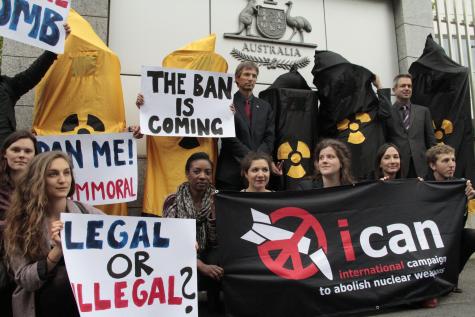
➡️ NUCLEAR ABOLITION DAY - September 26 - International Day for the Total Elimination of Nuclear Weapons
Nuclear Abolition Day was established by the United Nations General Assembly in 2013. It provides an opportunity for individuals and organisations to come together and promote disarmament and urge governments to commit to a world free from nuclear weapons.
The event is spearheaded by anti-nuclear organisations such as ICAN, CNDUK, Pax Christi, IPPNW, Unfold Zero, and the IPB. Organisations use the day to enhance public awareness and education about the threat posed to humanity by nuclear weapons and the urgent need for their total elimination.
Jump straight to our resources on ➡️ Nuclear Abolition Day
Explore our comprehensive guides on -
-
The Dangers of Nuclear Testing
-
Treaty on the Prohibition of Nuclear Weapons - TPNW
-
Nonproliferation Treaty - NPT
-
New START Treaties
-
The Enormous Dangers & Costs of Nuclear Proliferation
-
The Doomsday Clock
Please share our post on Twitter / X, Bluesky, Instagram, Facebook, and LinkedIn ;-)
*****
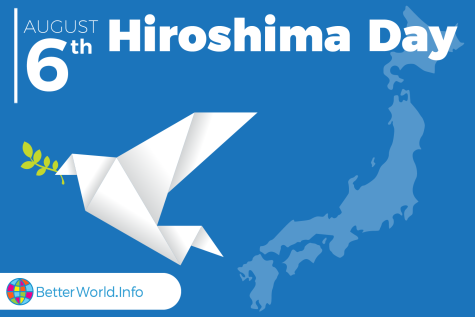
The U.S. atomic bombing of the Japanese city Hiroshima on August 6, 1945, marked the first time in world history that a nuclear weapon was deployed. The bomb immediately killed 80,000 people, mostly civilians, and flattened and burnt 70% of everything within a one-mile radius. The bombing of Nagasaki took place just a few days later on August 9th, an act which Oppenheimer himself believed was unnecessary and unjustified.
In 1946, in its very first resolution, the General Assembly identified nuclear disarmament as a leading goal of the United Nations. The nuclear arms race began in the 1950s. The 1962 Cuban Missile Crisis, one of the most dangerous moments in human history, prompted governments in Latin America to negotiate a treaty to prohibit the use of nuclear weapons. The NPT entered into force in 1970. It is the most widely signed disarmament agreement. As of 2016, 191 states have become parties to the treaty.
In 2017, the Treaty on the Prohibition of Nuclear Weapons (TPNW) was adopted. This was the first multilateral legally binding instrument for nuclear disarmament in 20 years. It entered into force in 2021 and now has 94 signatories and 73 states parties.
The TPNW prohibits the development, testing, production, stockpiling, transfer, use and threat of use of nuclear weapons. Although the TPNW was a milestone achievement, its success is limited while none of the nuclear-armed states have signed the treaty.
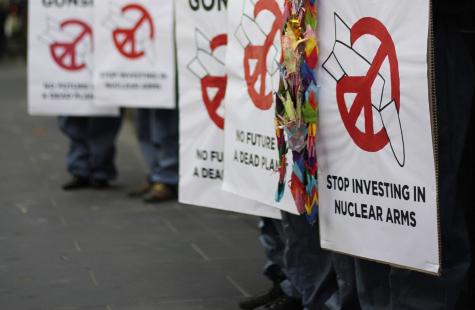
Humanitarian & Environmental Impacts of Nuclear Weapons
The atomic bombs of Hiroshima and Nagasaki were responsible for the deaths of 214,000 innocent civilians. This does not include the thousands who later lost their lives due to leukaemia, cancer, or other terrible side effects from the radiation.
Atomic bombs are the only devices invented which are capable of destroying all life on Earth. They pose the single largest threat to mankind and our environment. Even a small-scale nuclear war would result in decades of damage to our climate and ecosystems.
"It would take less than 0.1% of the explosive yield of the current global nuclear arsenal to bring about devastating agricultural collapse and widespread famine" - ICAN
Nuclear weapon stockpiling puts humanity on the brink of disaster, at the mercy of world leaders and their 'red buttons'. Just one small error in communication or misunderstanding could set the world on fire, and it almost has.
It is globally agreed that no state would be able to control or handle the effects of even a single nuclear missile detonation in an urban area. The vast health and environmental needs, both short and long-term, would be left unmet. The fallout of radiation sickness, ecocide, nuclear holocausts, and nuclear winters is unimaginable.
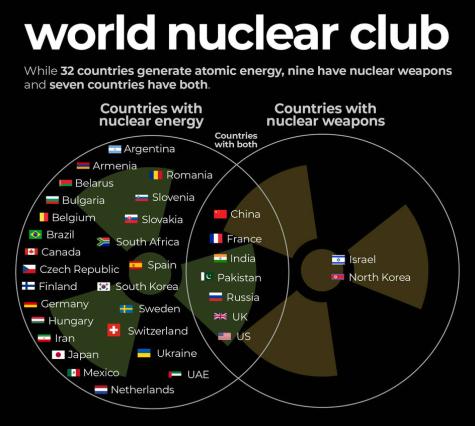
The Nine Nuclear States
In 2024, the nine nuclear states spent, or rather squandered, a combined total of $100 billion on nuclear weapons! Over the past five years, spending has increased by 47%, a dangerous and worrying trend.
Despite disarmament efforts, around 12,241 nuclear weapons remain today. All nuclear states have well-funded, long-term plans to modernise and expand their nuclear arsenals. More than half of the world's population lives in countries that either have atomic weapons or are members of nuclear alliances such as NATO.
There are currently no nuclear disarmament negotiations underway, and as a result, frustration is growing among non-nuclear states regarding the slow pace of nuclear disarmament.
Russia, with the largest stockpile, possesses 4,380 nuclear warheads. The risk of nuclear war over Ukraine is very real. Putin, on multiple occasions, has threatened the use of atomic weapons in the case of NATO intervention and has created a nuclear safety crisis by allowing attacks to take place near the Zaporizhzhia nuclear power plant.
In early 2023, Russia suspended its participation in the New START nuclear arms treaty.
Taking second place is the U.S.A., with an equally terrifying 3,708 nuclear weapons at home and abroad in the Netherlands, Germany, Turkey, Italy, and Belgium. In 2024, the U.S. spent more than all of the other nuclear-armed states combined, an enormous $56.8 billion.
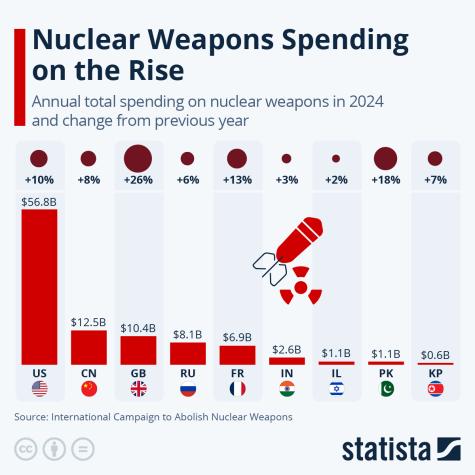
China, with 600 nuclear weapons in its arsenal, ranks third. France, with 300, ranks as fourth, and despite a large majority of citizens opposing the French nuclear weapons program, the government has resisted signing any treaty supporting nuclear disarmament.
Closely behind France is the UK, which is currently in possession of 225 nuclear weapons, with plans to increase this to 260 in the next few years. The controversial nuclear program Trident, a round-the-clock submarine nuclear missile system, comes at a cost of £205 billion to British taxpayers.
India and Pakistan possess a total of 334 nuclear weapons between them, with roughly equal numbers each. The secretive nuclear weapons program in Israel is of paramount concern, given the fragility of the situation between Israel and Palestine. Israel's nuclear weapons arsenal is estimated to be 90.
The data on the North Korean nuclear arsenal is somewhat ambiguous; the figure lies somewhere between 20 and 50. They are the only state to have conducted weapons testing in the 21st century.
In Iran, the Nuclear Deal was designed to control tensions between Israel and Iran. In an effort to halt Iran's nuclear program and to promote stability in the region, the arms control agreement provided billions in sanctions relief. The deal was forged in 2015 but is currently under negotiation after it was abandoned by Trump in 2018, and Iran committed a series of violations.
A new urgency to finalise a deal came after Israel and the U.S. illegally bombed Iran in June 2025. They targeted nuclear facilities, factories, senior military commanders and nuclear scientists. Netanyahu states that the attacks were a "pre-emptive" move in response to the expansion of Iran's nuclear weapons program. It came just days before the U.S. were due to commence diplomatic nuclear talks with Iran in Oman.
Talks are underway but look set to fail as Iran announced it has ended its cooperation with the IAEA, and Western nations are set to bring in new UN sanctions amid serious concerns that war could erupt with Israel.
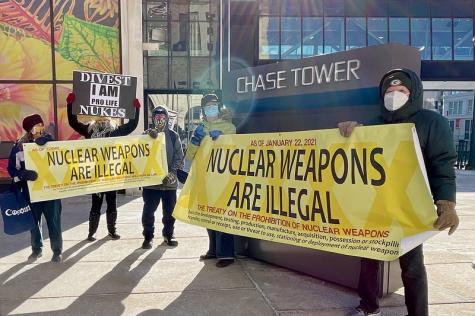
Nuclear Abolition for a Better World
There has never been a more pressing time to ban weapons. This year, the Doomsday Clock, set by The Bulletin of Atomic Scientists, was moved forward to 90 seconds to midnight. This signifies that we are now closer than ever to a global catastrophe.
It is more important now than ever for our world leaders to step up and fight for a nuclear-weapon-free world, recommit to disarmament treaties, and engage in negotiations to reduce global nuclear arsenals. There is an urgent need for a cooperative international effort to prevent nuclear warfare and ensure a safer future for everyone.
Under the thin veil of nuclear deterrence, nuclear stockpiles are really just a plot for potential mass murder and genocide. We must put pressure on our governments to show them that we do not support wild spending on nuclear weapons programs. Meanwhile, our social security networks are plundered, and our healthcare systems are failing.
On Nuclear Abolition Day and every day, Better World Info supports a total ban on the proliferation, stockpiling and use of all nuclear weapons. Aside from the risk of total global annihilation, billions are drained from essential social, health, and environmental budgets.
We are gaslighted by governments that claim nuclear programs are necessary to counter threats to our national security. Imminent threats to our planet include climate change, biodiversity loss, pollution, disease, water scarcity, and food insecurity. Nuclear weapons cannot solve any of these issues.
Author: Rachael Mellor, 23.09.25 licensed under CC BY-SA 4.0
For further reading on Nuclear Abolition Day see below ⬇️
- International Day for the Total Elimination of Nuclear Weapons - UN150870
- Joint Appeal for Nuclear Abolition Day, September 26, 2025 - NuclearAbolitionDay.org486846
- Nuclear Weapons Elimination Day 2023 - Unfold Zero373369
- 2023 Take ACTION on September 26 - Unfold Zero150866
- UNFOLD Zero ! - September 26 - UN Initiative150867
- September 26 - Will You Unfold Zero? - Abolition 2000150869
- UN Day of Nuclear Abolition - Peace Foundation (Archive)150871
- Nuclear ZERO Lawsuits (Archive)150865
- @NuclearBan150877
- @globalzero307010
- Facebook - Unfold Zero150872
- Google News - Unfold Zero150873
- Wikipedia - Global Zero150874
- YouTube150875
- YouTube Channel150876
- #DemandZero150878
- #NuclearZero150879
- #EliminateNukes 490153
- #UnfoldZero150880
- #IDTENW307009
- #GoodByeNukes150882
- #nuclearban307008
- #TPNW307007
- #ICantSleepBecause150884
- #NukesAgainstHumanity150883
- #NuclearAbolitionDay373791
- #TotalEliminationofNuclearWeapons373789
- #NuclearDisarmament373788
- Google Images150885
- Google Images - Unfold Zero150886
- Our TWEET on the topic - please share307120
- Our FACEBOOK post on the topic - please share307121
- Our INSTAGRAM post on the topic - please share307122
- Letter to BRICS Leaders regarding nuclear abolition373371
- Joint Appeal sent to UN Member States - Mail Chi 492260
- Support grows for Nuclear Taboo from Norm to Law - No First Use 373370
- Joint Appeal for the International Day for the Total Elimination of Nuclear Weapons487487
- Join a social media action: Don't even THINK about starting a nuclear war - No First Use373373
- Civil Society Calls on UN Disarmament Committee to Stop Nuclear Weapons - Nuclear Abolition Day 19.10.25494474
- The UK was just exposed for breaching the nuclear non-proliferation treaty - Canary 26.09.25490591
- Intensifying threat looms large as UN highlights the world’s growing nuclear arsenals - UN News 26.09.25490441
- Legal opinion finds Britain’s nuclear expansion breaches nuclear Non-Proliferation Treaty - CND UK 26.09.25490149
- Secretary-General's message on the International Day for the Total Elimination of Nuclear Weapons - UN 26.09.25490147
- Tweet: Did you know the very first UN General Assembly resolution was on nuclear disarmament? - @nuclearban 26.09.25490151
- Tweet: SGR has joined 100s of organisations and individuals in signing the joint appeal to world leaders on this International Day for the Total Elimination of Nuclear Weapon…490154
- Fighter jets purchase would put UK in breach of nuclear treaty, says CND - Guardian 26.09.25490152
- Disarmament over destruction: A renewed push for a world without nuclear weapons - UN News 25.09.25490447
- International Day for the Total Elimination of Nuclear Weapons: Real peace can never exist under the threat of annihilation - ITUC 25.09.25490150
- Disarmament over destruction: A renewed push for a world without nuclear weapons - UN 25.09.25490148
- Message for the International Day for the Total Elimination of Nuclear Weapons - UN 23.09.25494475
- Defining Our Role in the Wake of the International Day of Peace - CD 22.09.25489623
- Endorse the Appeal for the Elimination of Nuclear Weapons - Pax Christi USA 20.09.25489622
- Demanding Disarmament and Demilitarisation at the UN General Assembly - Reaching Critical Will 17.09.25489624
- ‘Nuclear Weapons Deliver Only Annihilation, Not Security', Stresses Secretary-General, Marking International Day - UN 12.09.25487485
- Pax Christi International joins global campaign for Nuclear Abolition Day 2025 - Pax Christi 11.09.25487486
- Stop Nuclear Weapons: Peace is in our Hands - Nuclear Abolition Day 29.08.25486148
- The threat to end civilization has never been — and never will be — a guarantor of global peace or national security - IPPNW 27.09.24434227
- Tweet: “The time for the total elimination of nuclear weapons is now.”— @antonioguterres urges countries at #UNGA to take concrete steps toward ending the nuclear threat and …433238
- Why the Total Elimination of Nuclear Weapons is more urgent than ever on this International Day - ICAN 26.09.24433217
- Secretary-General's remarks at High-level Meeting Commemorating and Promoting the International Day for the Total Elimination of Nuclear Weapons - UN 26.09.24433239
- Tweet: Today is the International Day for the Total Elimination of Nuclear Weapons and (everyday but particularly today) we want to amplify #nuclearsurvivors voices because n…433236
- Video: High-level Meeting on International Day for the Total Elimination of Nuclear Weapons - UN Foundation 26.09.24433240
- Tweet: “The only way to eliminate the nuclear threat is to eliminate nuclear weapons.”— @antonioguterres on Thursday's International Day for the Total Elimination of Nuclear …433237
- International Day for the Total Elimination of Nuclear Weapons shows there is no middle ground in the struggle for a world free of nuclear weapons - Reaching Critical Will 29…375072
- Secretary-General's message on the International Day for the Total Elimination of Nuclear Weapons - UN 26.09.23373787
- Tweet:Nuclear risks are higher than ever before. The international community must take urgent steps to eliminate #NuclearWeapons and other weapons of mass destruction. Global…373792
- Only way to end nuclear risk ‘is to eliminate nuclear weapons’: Guterres - UN 25.09.23373790
- Ending Nuclear Tests, Abolishing Nuclear Weapons - WILPF 29.08.23373793
- ICAN statement to the UN event on the International Day for the Total Elimination of Nuclear Weapons 2023 - Pressenza 27.09.23374433
- Eliminating Nuclear Weapons 'Is Not Only Possible, It Is Necessary': UN Chief - CD 26.09.22311736
- Video: Abolish Nuclear Weapons? A Soho Forum Debate - Reason 26.09.22307062
- High-level plenary Meeting Total Elimination of Nuclear Weapons - YouTube 26.09.22307015
- UNGA set to end high-level meetings as geopolitical rifts threaten to erode multilateral mechanism - GT 26.09.22307017
- UN in Vienna Celebrates the International Day for the Total Elimination of Nuclear Weapons - Vindobona 25.09.22307061
- Banish Nuclear Weapons ‘to History Books, Once and for All’, Urges Secretary-General, Marking International Day - UN 13.09.23373374
- International Day for the Total Elimination of Nuclear Weapons - UN 08/22307013
- International Day for the Total Elimination of Nuclear Weapons - YouTube 27.01.22307014
- Int'l Day for the Total Elimination of Nuclear Weapons - UN chief 29.09.21307012
- Nurses not Nukes: Mark the International Day for the Total Elimination of Nuclear Weapons - CND 12.08.21255552
- Day For the Total Elimination of Nuclear Weapons - YouTube 02.10.20307011
- Commemorating the 74th Anniversary of the first UN Resolution 1 (1): Elimination of Nuclear Weapons - 16.01.20197402
- FOR at the UN's International Day for the Total Elimination of Nuclear Weapons - YouTube 29.09.20307016
- ICAN statements at the UN for International Day for the Total Elimination of Nuclear Weapons - ICAN 27.09.18307064
- Communities of faith and the new treaty prohibiting nuclear weapons - Unfold Zero 7/17150887
- UN Secretary-General’s Message for Sep 26, 2015150868
- (Don't Want Your) Nuclear Umbrella - YouTube 9/14150888
- Call for Action - International Day for the Total Elimination of Nuclear Weapons 2014150890
- Broken Chair and Nuclear Bans - Huff Post 9/14150891
- Ban on Nuke Tests OK, But Where’s the Ban on Nuke Weapons? - IPS 8/14150892
- Hollywood Stars 'demand Zero' Nuclear Weapons -YouTube 6/13150889
- Movie: Embrace! A world free of nuclear weapons - United Nations 15.09.10307059
- Mayors for Peace - Our Links150893
- Basel Peace Office150894
- Prague Vision150895